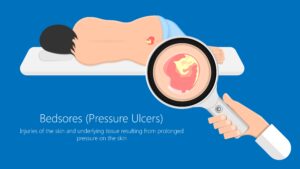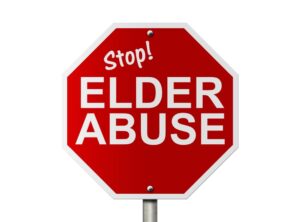Bedsore Stages
BedsoresBedsores are common in nursing homes, where residents may have limited mobility. Understanding the stages of bedsores—from initial redness to severe tissue damage—is crucial for recognizing signs of a problem and taking prompt action.
Proper nursing home care should prevent bedsores, but their presence often indicates inadequate attention to a resident’s needs. A nursing home attorney can help victims and their families pursue legal remedies and obtain compensation from those responsible for this severe form of neglect.
What Are Bedsores?

Bedsores, often called pressure ulcers or decubitus ulcers, are injuries to the skin and tissue typically occurring due to prolonged skin pressure. They commonly develop on areas of the skin covering bony areas of the body, such as the heels, ankles, hips, and tailbone. Bedsores are a significant concern in nursing homes and other long-term care settings where residents may have limited mobility.
Definition and Common Causes
Bedsores occur when sustained pressure against the skin reduces blood flow to the affected area. Without adequate blood flow, the affected tissues lack oxygen and essential nutrients, leading to tissue damage and eventual death. Common causes include:
- Prolonged immobilization: Patients confined to beds or wheelchairs for extended periods are at high risk.
- Poor nutrition and hydration: Insufficient intake can weaken skin and make it more susceptible to damage.
- Medical conditions affecting blood flow: Conditions like diabetes and vascular diseases can increase the risk of bedsores.
- Inadequate nursing care: Lack of regular repositioning and poor hygiene practices contribute significantly to the development of bedsores.
Stages of Bedsores
Bedsores, also known as pressure ulcers, progress through four distinct stages, each increasing in severity and potentially impacting health. Understanding these stages helps identify the level of neglect and informs necessary legal actions to protect and seek justice for nursing home residents.
Stage 1
The skin appears reddened when pressed but doesn’t blanch (turn white). The area may feel warm, firm, or tender. This stage is an early warning sign of neglect. Prompt attention and care can prevent further deterioration. Neglect at this stage indicates inadequate monitoring and repositioning of immobile residents, a fundamental aspect of primary care.
Stage 2
There is partial thickness loss of skin, presenting as a blister, abrasion, or shallow open sore. The area around the sore may be discolored. At this stage, the sore signifies worsening neglect and an increased risk of infection. Proper wound care and increased vigilance are essential to prevent progression. Failure to address these sores can lead to more severe health issues, indicating a deeper level of negligence.
Stage 3
The ulcer becomes a deep wound with full-thickness skin loss, exposing fat tissue. The sore may look like a crater and extend deeper into the skin layers.
Severe neglect is evident at this stage, with a significant potential for serious health complications such as infection and necrosis (tissue death). Advanced medical intervention is required, and the presence of stage 3 bedsores strongly indicates systemic neglect within the care facility.
Stage 4
Description: There is even more substantial tissue loss with exposed muscle, bone, or tendons. The wound is deep and often infected, with dead tissue (eschar) visible.
Stage 4 bedsores represent critical neglect, posing a high risk of severe infection and possible fatality. This level of neglect reflects grossly inadequate care and oversight, necessitating immediate medical attention and legal action to address the abuse and prevent further harm.
The Legal Aspects of Bedsore Cases
Recognizing the stages of bedsores is crucial in the legal context, as these stages can provide clear evidence of nursing home neglect and abuse. Understanding the severity and progression of bedsores will help your nursing home abuse lawyer build a strong case against those who fail to provide residents with adequate care.
The Importance of Recognizing Bedsore Stages in Legal Context
The progression of bedsores from Stages 1 to 4 demonstrates the extent of neglect over time. Identifying the stage of a bedsore can indicate how long the resident has been suffering and the level of neglect they have endured. Early-stage bedsores suggest a lapse in care that prompt intervention can rectify. At the same time, advanced stages indicate prolonged neglect and a system-wide failure to address the resident’s needs.
A skilled nursing home attorney will obtain detailed documentation of the bedsore stages. This documentation can serve as compelling evidence of neglect. Medical records, photographs, and expert testimonies can help establish the timeline and severity of the neglect. This evidence is critical in proving that the nursing home breached its duty of care, harming the resident.
Signs That a Loved One May Be Suffering from Bedsores

Recognizing the early signs of bedsores can help families take prompt action to protect their loved ones. The initial symptoms include:
- Reddened skin: Persistent redness on the skin, particularly in bony areas like heels, hips, and tailbone, indicates the early stage of bedsores. If the redness doesn’t blanch (turn white) when pressed, it’s a warning sign.
- Blisters or open sores: The presence of blisters, abrasions, or shallow open wounds suggests that bedsores are progressing to more severe stages and require immediate attention.
- Pain and discomfort: Residents may complain of pain or discomfort in areas constantly under pressure, potentially a sign of developing bedsores.
- Swelling: Inflammation or swelling around the affected area can indicate infection, often accompanying advanced bedsores.
- Changes in skin texture: The skin may feel warmer or cooler than surrounding areas, and there may be changes in texture or color.
Other Indicators of Neglect or Abuse in Nursing Homes
Bedsores are a clear sign of neglect, but other indicators can also signal broader issues of mistreatment or inadequate care in nursing homes:
- Malnutrition and dehydration: Unexplained weight loss, dry mouth, sunken eyes, and overall frailty can indicate that a resident is not receiving proper nutrition and hydration. This neglect can severely impact their health and well-being.
- Poor hygiene: Dirty clothing, unwashed hair, and soiled bedding suggest that the nursing home staff is neglecting basic hygiene needs. This neglect can lead to infections and other health issues.
- Untreated medical conditions: Persistent infections, untreated injuries, and worsening chronic conditions without appropriate medical intervention are signs of medical neglect.
- Emotional and behavioral changes: Sudden changes in behavior, such as withdrawal, anxiety, or depression, can indicate emotional or psychological abuse. These changes may occur due to mistreatment or neglect.
- Unexplained bruises or injuries: Frequent bruises, cuts, or fractures that the staff cannot adequately explain may be signs of physical abuse or rough handling.
- Lack of mobility assistance: Residents left in the same position for extended periods may develop bedsores and other complications. This lack of mobility assistance indicates severe neglect.
- Overmedication or sedation: Overuse of sedatives or other medications to control residents’ behavior is a form of abuse. Look for signs like excessive sleepiness or lethargy.
The Legal Rights of Nursing Home Residents

Nursing home residents are protected by a comprehensive set of rights under federal and state laws to ensure their safety, dignity, and quality of life. The Nursing Home Reform Act, part of the Omnibus Budget Reconciliation Act of 1987, is a key piece of federal legislation establishing residents’ rights. These include the right to:
- Dignity and respect: Residents have the right to be treated with respect and dignity.
- Freedom from abuse and neglect: They must be protected from physical, emotional, and financial abuse and neglect.
- Privacy: Residents have the right to privacy in personal and medical matters.
- Participate in their care: They can be involved in planning their care and have the right to refuse treatment.
- Access to information: Residents have the right to access their medical records and be informed about their health status.
Specific Protections Against Neglect and Abuse
Federal regulations mandate that nursing homes provide adequate staffing, proper nutrition, and necessary medical care to prevent neglect and abuse. Specific protections include:
- Regular inspections: Nursing homes are subject to regular inspections to ensure compliance with care standards.
- Resident advocacy: Ombudsman programs are available to advocate for residents’ rights and address complaints.
- Training requirements: Staff must be trained to recognize and prevent abuse and neglect.
State laws may provide additional protections, such as stricter staffing ratios or enhanced penalties for violations.
The Importance of Proper Documentation and Reporting of Neglect
Proper documentation and reporting are crucial for addressing neglect and abuse in nursing homes. Accurate records can serve as evidence in legal proceedings and help regulatory agencies take corrective action. If neglect or abuse is suspected, it is essential to:
- Document evidence: Keep detailed records of injuries, medical conditions, and any changes in behavior.
- Report immediately: Inform nursing home administrators and file complaints with state regulatory agencies.
- Seek legal advice: Consult with a nursing home abuse lawyer to explore legal options and ensure that the resident’s rights are protected.
Proper documentation and reporting can help prevent further abuse, hold perpetrators accountable, and improve care standards for all residents.
Steps to Take if You Suspect Neglect or Abuse
If you discover a loved one in a nursing home has bedsores, immediate action is crucial to address the issue and prevent further harm.
- Inspect the severity: Carefully examine the bedsores to determine their stage and severity. Note any signs of infection, such as redness, swelling, or discharge.
- Inform nursing home staff: Notify the nursing home staff immediately about the bedsores. Request an explanation and immediate medical intervention to treat the sores and prevent further damage.
- Ensure proper care: Advocate for appropriate care measures, including regular repositioning, proper nutrition, and hydration, to prevent the condition from worsening.
Medical Evaluation and Documentation
Proper medical evaluation and documentation are critical for the resident’s health and potential legal action.
- Seek medical attention: Arrange for a thorough medical evaluation by a healthcare professional who can assess the bedsores and recommend appropriate treatment.
- Document everything: Keep detailed records of the bedsores, including photographs, dates, and any communications with the nursing home staff. Document the treatment provided and any changes in the resident’s condition.
- Medical records: Obtain copies of medical records that document the presence and treatment of bedsores. These records can be crucial evidence if you decide to pursue legal action.
How a Nursing Home Abuse Attorney Can Help You Pursue Legal Remedies

If you suspect that a loved one has suffered neglect or abuse in a nursing home, consulting with a nursing home abuse lawyer is a critical step in seeking justice. An attorney can guide you on the legal options available.
Why You Need an Experienced Nursing Home Abuse Lawyer
Selecting a lawyer with experience in elder abuse cases is essential for several reasons:
- Experience: Nursing home abuse lawyers understand the laws and regulations governing nursing home care. They’re familiar with the nuances of these cases and can build a solid legal strategy.
- Resources: Experienced attorneys have access to a network of medical experts, investigators, and other professionals who can provide crucial support and testimony.
- Track record: A lawyer with a successful track record in nursing home abuse cases is likelier to achieve a favorable outcome for their clients.
Steps Involved in Filing a Lawsuit
While no two cases are exactly alike, these are some of the typical steps in a nursing home abuse lawsuit.
- The initial consultation: During the initial consultation, your nursing home abuse attorney will review the details of your case, assess the viability of a lawsuit, and explain the legal process.
- Filing a complaint: The nursing home abuse lawyer will draft and file a legal complaint against the nursing facility, outlining the allegations and the harm suffered. It initiates the legal proceedings.
- Legal proceedings: The discovery process starts once your lawyer files the complaint. During this phase, they exchange information and evidence with the defendant. Depositions, interrogatories, and expert testimony are crucial components.
Many nursing home abuse cases settle out of court. A settlement can compensate for medical expenses, pain and suffering, and other damages without a lengthy trial. If the two sides can’t agree on a fair resolution, the case may go to trial. A court judgment can often result in compensation for the victim and set a precedent that helps protect other residents from similar neglect or abuse.
Contact a Nursing Home Abuse Attorney
If you suspect your loved one is a victim of neglect or abuse in a nursing home, don’t wait. Take immediate action to protect their well-being. Contact an experienced personal injury lawyer for a free consultation to discuss your case and explore your legal options. Your loved one deserves justice and quality care—a skilled attorney will help you ensure they receive it.
Nathan Hughey, an attorney and fourth-generation South Carolinian, founded Hughey Law Firm in 2007. Before that, he spent five years defending nursing homes and insurance companies. Leveraging his experience, he now advocates for those injured or wronged by such entities, securing over $220 million in verdicts and settlements.
